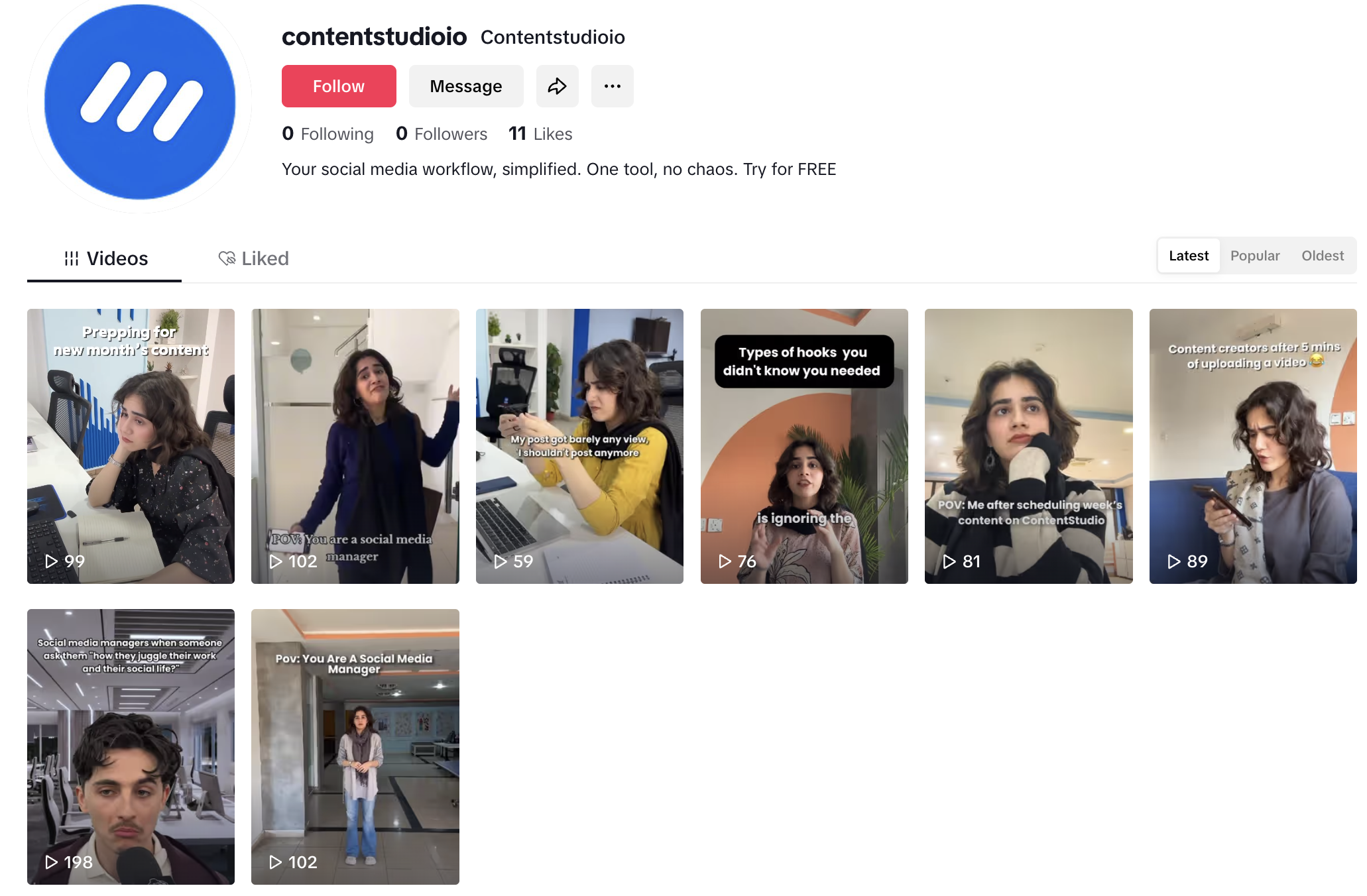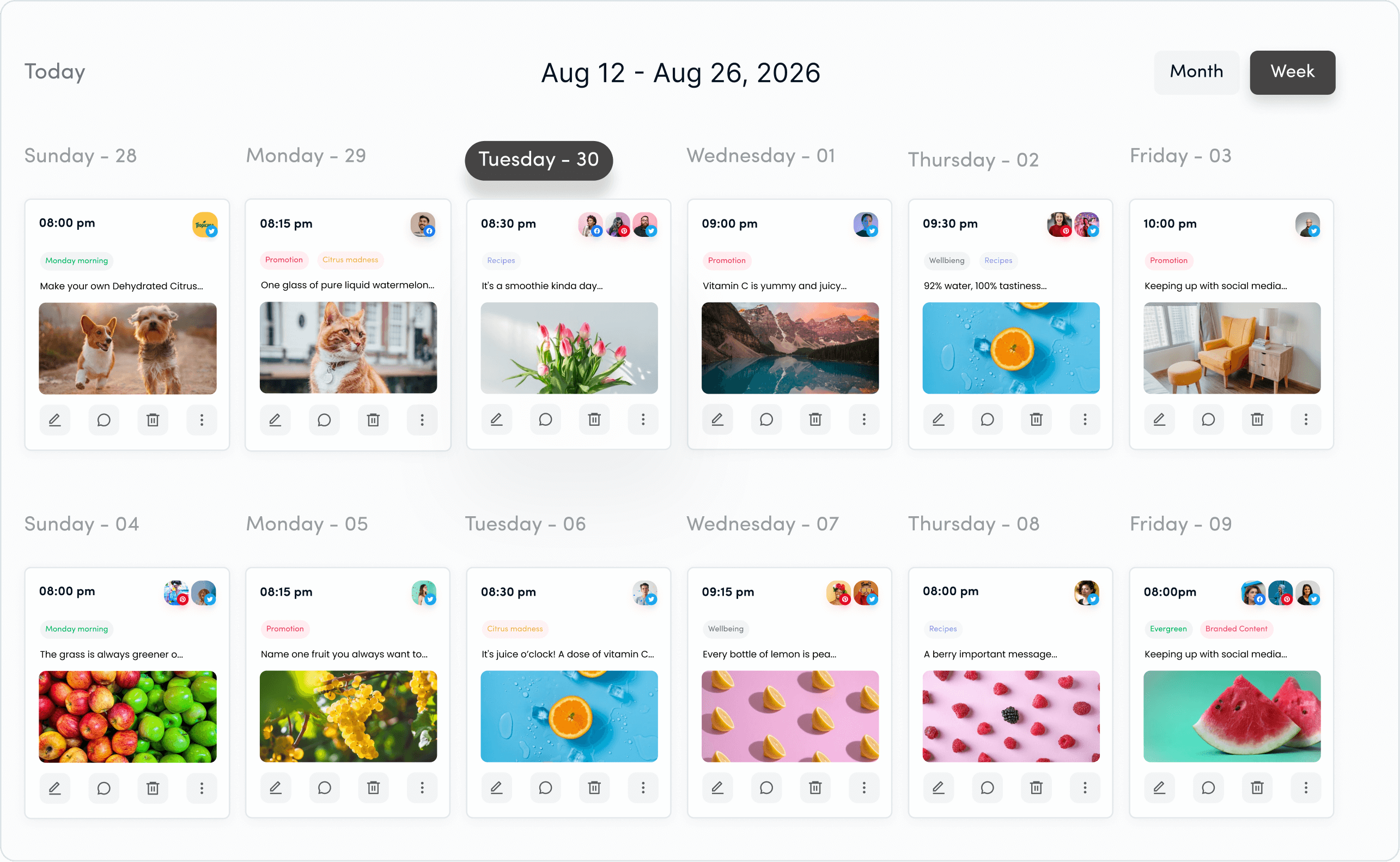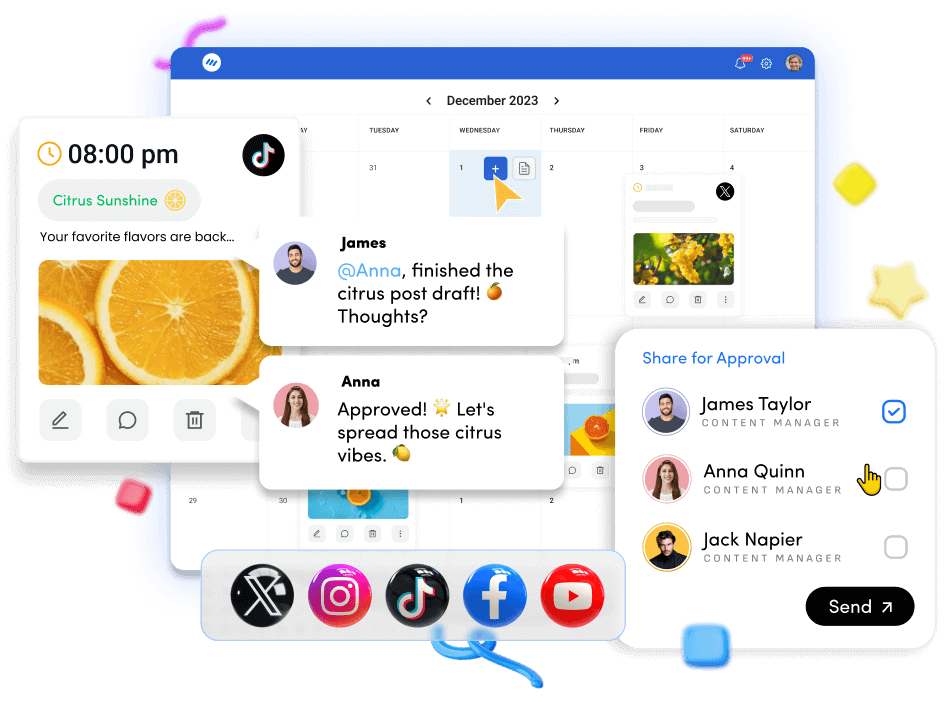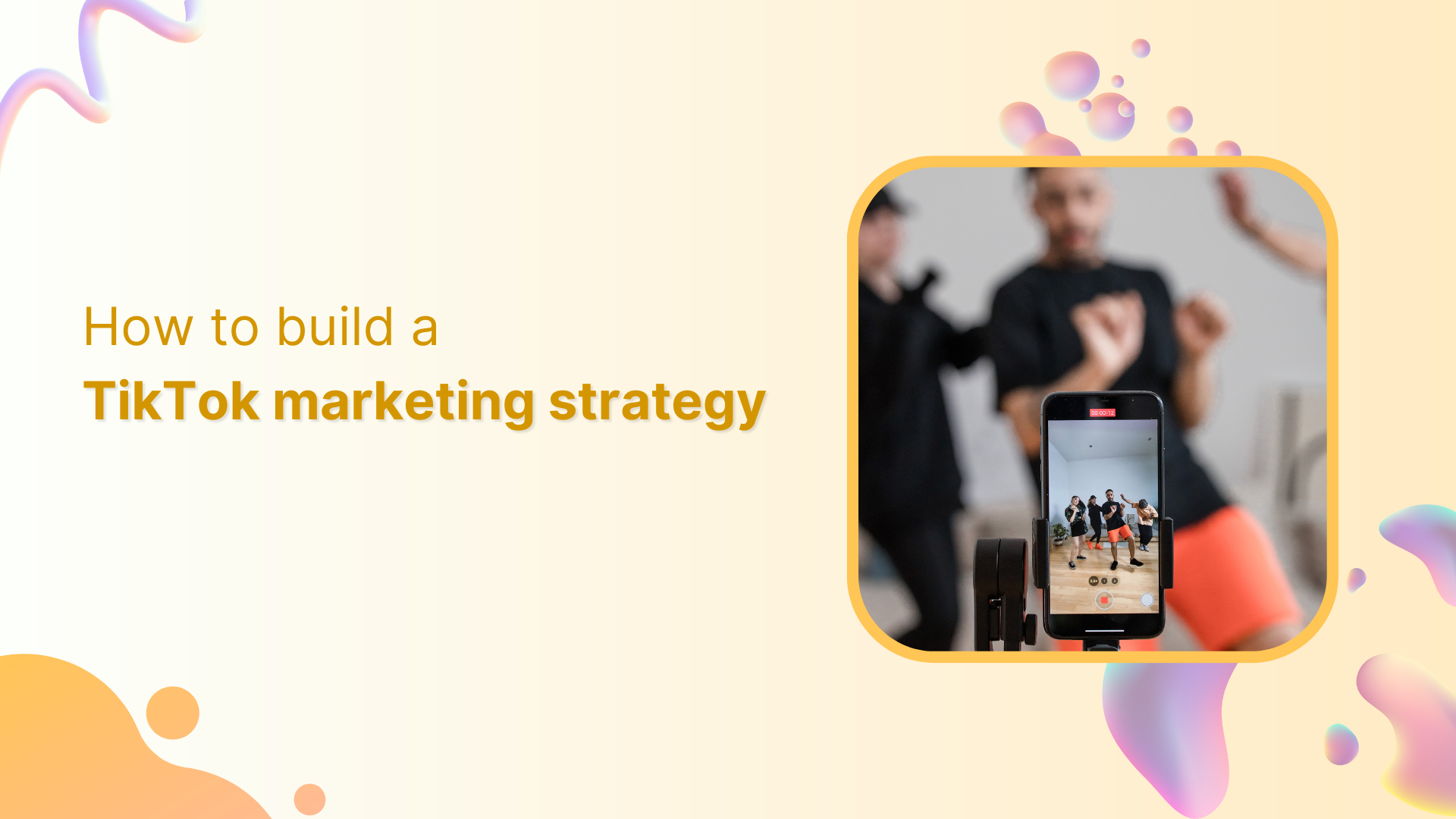With over 1.5 billion active users globally and users spending an average of 58 minutes per day on the app, TikTok has evolved from a platform for dance videos into a robust marketing ecosystem that’s reshaping how brands connect with consumers.
But here’s the challenge: TikTok’s unique algorithm, fast-moving trends, and Gen Z-dominated culture require a completely different approach than traditional social media marketing. TikTok reached 1 billion users in just four years since its worldwide launch—a milestone that took Facebook and Instagram eight years to achieve, proving that speed and agility are crucial on this platform.
This comprehensive guide will equip you with the strategies, tools, and insights needed to build a successful TikTok marketing strategy in 2025. You can also learn how to utilize TikTok’s unique features to enhance brand awareness, increase engagement, and drive sales.
What is TikTok Marketing?
TikTok marketing is the process of utilizing TikTok and its content to promote a brand and its products or services through short-form video content that engages audiences and showcases business offerings. Unlike traditional social media marketing that creates cohesive strategies across all platforms, TikTok marketing focuses exclusively on TikTok’s unique content style and algorithm.

TikTok vs. Other social media platforms: Key differences
TikTok fundamentally differs from other social media platforms in several crucial ways:
- Algorithm-driven discovery: TikTok prioritizes content discovery over showing you content from your friends. The For You Page prioritizes videos from creators you’ve never seen before, giving marketers unprecedented reach potential regardless of follower count.
- Authentic, raw content: In the world of TikTok, genuine content reigns supreme. Users prefer raw and engaging TikTok videos over highly edited, curated posts that are more suitable for Instagram or Facebook.
- Trend-driven culture: TikTok’s ecosystem revolves around rapidly evolving trends, sounds, and challenges that can propel content to viral status within hours.
- Search engine functionality: 40% of young people, particularly Gen Z, primarily use TikTok and Instagram to search for things like restaurants, makeup tips, and more, making TikTok SEO increasingly important.
Plan, schedule, share, and analyze content for 15+ social media channels.
Try ContentStudio for FREE
How to set up your TikTok Marketing foundation
Before launching your TikTok marketing strategy, you need to establish a professional presence on the platform. Here’s your step-by-step setup guide:
Step 1: Choose business vs. creator account
Before setting up your account, you need to understand the key differences between TikTok Business and Creator accounts:
TikTok business account benefits
- Access to TikTok Ads Manager for paid advertising campaigns
- Advanced analytics and performance insights
- Ability to create an ecommerce storefront with TikTok Shop
- Commercial music library access (business-safe sounds)
- Contact information display (email, phone, website)
- Third-party tool integration for scheduling and management
- Custom call-to-action buttons
TikTok creator account benefits
- Access to a complete music library (including copyrighted songs)
- Creator Fund monetization opportunities
- More detailed analytics on video performance
- Creator Marketplace access for brand partnerships
- Live streaming gifts and monetization features
Key limitations:
- Business accounts have limited access to copyrighted music and trending sounds
- Creator accounts cannot run paid ads or access business-specific tools
Recommendation: For marketing purposes, consider a Business account, despite the music limitations, as its advertising capabilities and analytics are essential for business growth.
Step 2: Account setup process
- Download the TikTok app and create a new account
- Navigate to your profile and tap the hamburger menu
- Select “Settings and privacy.”
- Tap on “Account.”
- Choose “Switch to Business Account.”
- Select your business category and register now.
Step 3: Profile optimization
- Profile photo/video: Use a high-resolution version of your logo or create an animated logo video
- Username: Match your business name (if possible) without spaces
- Bio: Utilize all 80 characters to describe what your business does
- Contact information: Add your business email and website link (available after reaching 1,000 followers)
- Category: Select the most relevant business category
The 10 core TikTok marketing strategies
1. Trend participation and trendjacking
If you want to increase your chances of going viral, pay attention to trending audio clips, challenges, and video types. If you can use a popular trend to create a video that’s relevant to your business, do so!
Implementation strategy:
- Monitor TikTok’s Discover page daily for emerging trends
- Use TikTok’s creative center for trend insights
- Set up Google alerts for trending hashtags in your industry
- Create a trend calendar to track seasonal and recurring trends
- Adapt trends to fit your brand voice and message within 24-48 hours
- Act quickly—trends have short lifespans (typically 3-7 days)
Real-life example: Relatable artist content
Artist Nataliia demonstrates perfect trend participation by adapting popular meme formats to her art niche. In her viral video “Every artist after finishing their artwork,” she:
- Used the popular “Every [type of person] after [situation]” meme format
- Made it relatable to her specific audience (artists and art lovers)
- Incorporated trending audio (peekaboo – @Kendrick Lamar)
- Showed her authentic art studio environment
- Used relevant hashtags (#art #artist #painter #artistjoke #fineart)
- Achieved 360.3K views with high engagement
Implementation tips
- Use trending sounds within the first 24 hours of popularity
- Add your unique spin to existing trends
- Create trend-specific content calendars
- Monitor competitor trend adoption for inspiration
2. Authentic storytelling and behind-the-scenes content
TikTok audiences love authentic content. The more honest your marketing appears, the more likely viewers are to trust you. Behind-the-scenes content humanizes your brand and builds trust with your audience.
Content categories
- Product creation process: Show how your products are made
- Team introductions: Introduce team members and their roles
- Company culture: Share office moments and team interactions
- Customer stories: Feature real customer testimonials
- Problem-solving: Show how you handle challenges and mistakes
- Day-in-the-life: Follow employees through their workday
- Company history: Share your brand’s origin story
Real-life example: Scrub daddy’s transparent approach
Scrub Daddy has built a massive following by showcasing its product manufacturing process, team personalities, and honest reactions to customer feedback. Their behind-the-scenes content includes:
- Factory tours showing sponge production
- Team members testing products in real situations
- Honest responses to customer complaints
- Founder Aaron Krause’s involvement in content
- Raw, unfiltered moments that showcase authenticity
Content creation framework:
- Morning routine: Show how your team starts the day
- Problem-solving: Document how you handle customer issues
- Product development: Share the iteration process
- Team meetings: Give glimpses into decision-making
- Mistake recovery: Show how you handle errors transparently
3. User-generated content (UGC) campaigns
Nothing sparks social media engagement like a well-crafted challenge. Whether it’s a branded hashtag challenge or a fun, user-generated trend, influencers can engage their audience, thereby increasing their organic reach.
UGC campaign structure
- Branded hashtag challenges: Create memorable, actionable hashtags
- Product demonstration challenges: Show creative product uses
- Customer review campaigns: Encourage honest testimonials
- Contest and giveaway integrations: Incentivize participation
- Story sharing: Ask customers to share their experiences
- Creative challenges: Encourage artistic interpretations
Real-life example: Gymshark’s “66 days | Change your life” challenge
Gymshark launched the “66 Days | Change Your Life” challenge at the start of the year to encourage fitness resolutions. The campaign included:
- Clear challenge parameters (66 days of fitness commitment)
- Daily motivation and check-in content
- User submissions showcasing progress
- Community support and encouragement
- Influencer participation for credibility
- Prizes and recognition for participants
UGC campaign best practices:
- Make participation easy and accessible
- Provide clear instructions and examples
- Offer meaningful incentives (not just prizes)
- Showcase participant content regularly
- Respond to all UGC submissions
- Create compilation videos of the best submissions
4. TikTok influencer marketing and partnerships
Unlike traditional influencer marketing strategies that rely on big-name personalities, TikTok suggests that brands partner with influencers and creators who can connect with specific communities.
Influencer strategy framework
- Nano-influencers (1K-10K followers): Highly engaged niche audiences, cost-effective
- Micro-influencers (10K-100K followers): Authentic community connections, specialized niches
- Macro-influencers (100K-1M followers): Broader reach with maintained authenticity
- Mega-influencers (1M+ followers): Massive reach for brand awareness campaigns
Partnership types
- Product Seeding: Send free products for potential organic mentions
- Paid Partnerships: Formal agreements with guaranteed deliverables
- Long-term Ambassadorships: Ongoing relationships for consistent promotion
- Collaborative Content: Work together on creative concepts
- Takeovers: Let influencers control your account temporarily
Real-life example: Chipotle’s creator partnerships
Chipotle has built incredible success through authentic influencer partnerships, particularly with TikTok food reviewers Keila and Keith Lee. Their strategy included:
- Identifying food reviewers with authentic voices
- Allowing creators to maintain editorial control
- Responding to viral reviews with menu additions
- Creating long-term partnerships rather than one-off campaigns
- Leveraging viral moments to create official menu items
Influencer selection criteria
- Audience alignment with your target demographic
- Engagement rates over follower count
- Content quality and consistency
- Brand safety and values alignment
- Previous partnership performance
- Creative potential and innovation
5. Educational and value-driven content
Create content that teaches, informs, or solves problems for your audience. Educational content builds authority, trust, and keeps viewers coming back for more.
Educational content categories
- How-to tutorials: Step-by-step instructional content
- Industry insights: Share expertise and knowledge
- Product comparisons: Help customers make informed decisions
- FAQ responses: Answer common customer questions
- Tips and tricks: Share valuable shortcuts and hacks
- Myth-busting: Address common misconceptions
- Trend analysis: Explain industry developments
Real-life example: The home edit’s organization tips
The Home Edit has built a massive following by sharing organization tips and home improvement advice. Their educational content includes:
- Before-and-after transformation videos
- Step-by-step organizing tutorials
- Product recommendation explanations
- Space-specific organization tips
- Client consultation behind the scenes
- Q&A sessions addressing follower questions
Content structure for educational videos
- Hook (0-3 seconds): Present the problem or question
- Preview (3-5 seconds): Tease the solution
- Content (5-45 seconds): Deliver the educational value
- Call-to-action (45-60 seconds): Encourage engagement
- Follow-up: Respond to comments with additional tips
6. Interactive content and community Building
The more engagement a TikTok receives, the better it will perform in the algorithm’s ranking. Interactive content encourages participation and fosters a sense of community around your brand.
Interactive content types
- Questions and polls: Use comments for audience feedback
- Duet and stitch encouragement: Invite audience participation
- Challenge participation: Join trending challenges
- Live Q&A sessions: Real-time audience interaction
- Comment response videos: Address audience questions
- Choose your own adventure: Let the audience decide the content direction
- Voting content: Ask the audience to choose between options
Real-life example: Ryanair’s savage community management
Ryanair has built a cult following through its hilariously savage responses to customer complaints and those of its competitors. Their interactive approach includes:
- Responding to negative comments with humor
- Creating content based on customer feedback
- Engaging in playful “feuds” with competitors
- Duetting with customer videos
- Using customer stories as content inspiration
- Maintaining a consistent brand voice across all interactions
Community building strategies
- Create brand-specific hashtags for community use
- Regularly feature customer content and stories
- Respond to comments with video responses
- Host regular live sessions for direct interaction
- Create inside jokes and references for your community
- Acknowledge and celebrate community milestones
7. TikTok live streaming for real-time engagement
TikTok allows viewers to send stickers and other accolades through live videos as a monetization perk, so your brand can add TikTok Live as an additional revenue stream.
Live streaming content types
- Product launches: Unveil new products in real-time
- Behind-the-scenes events: Share exclusive moments
- Expert interviews: Host industry professionals
- Customer service sessions: Address concerns live
- Interactive tutorials: Teach while answering questions
- Q&A sessions: Direct audience interaction
- Collaborative streams: Partner with other creators
Real-life example: Sephora’s beauty tutorials
Sephora regularly hosts live streaming sessions featuring makeup tutorials, product demonstrations, and Q&A sessions with beauty experts. Their live strategy includes:
- Scheduled weekly live sessions for consistency
- Interactive makeup tutorials with real-time tips
- Product launches with live demonstrations
- Beauty expert interviews and advice
- Customer question responses during streams
- Exclusive live-only offers and discounts
Live streaming best practices
- Promote upcoming live sessions in advance
- Prepare talking points but remain flexible
- Engage with comments throughout the stream
- Save and repurpose live content for later use
- Use live streaming for time-sensitive announcements
- Collaborate with other creators for cross-promotion
8. Cross-platform content repurposing
You may end up repurposing your TikTok videos for Instagram Reels and YouTube Shorts to reach even more viewers. This strategy maximizes your content investment and extends your reach across platforms.
Repurposing Strategy Framework:
- TikTok to instagram reels: Adapt for Instagram’s audience
- TikTok to YouTube shorts: Optimize for YouTube’s algorithm
- TikTok to Twitter: Create short clips for Twitter videos
- TikTok to LinkedIn: Professional content for business networks
- TikTok to Pinterest: Create idea pins from tutorials
- TikTok to Blog Content: Expand videos into written articles
Real-life example: Gary Vaynerchuk’s content model
Gary Vaynerchuk has perfected the art of content repurposing by creating a single long-form piece and breaking it down into multiple short-form videos tailored for different platforms. His strategy includes:
- Creating daily long-form content (videos/podcasts)
- Extracting 5-10 short clips for TikTok
- Adapting clips for Instagram Reels and Stories
- Posting quotes and insights on LinkedIn
- Creating Twitter threads from key points
- Developing blog posts from comprehensive topics
Content adaptation guidelines:
- Instagram reels: Add captions and optimize for silent viewing
- YouTube shorts: Use landscape format when possible
- LinkedIn: Focus on professional insights and lessons
- Twitter: Create threaded content from longer videos
- Pinterest: Design quote cards and tutorial pins
- Blog: Expand video content into detailed articles
9. TikTok shopping and e-commerce integration
With 51.9% of marketers actively selling through TikTok Shop, it’s clear that this new feature is being embraced for its potential to drive direct sales and streamline the shopping experience.
E-commerce strategy components
- TikTok shop integration: Set up in-app shopping
- Product showcase videos: Highlight products in use
- Shoppable live streams: Sell products during live sessions
- Affiliate marketing programs: Partner with creators for sales
- In-App checkout: Streamline the purchase process
- Product reviews: Showcase customer testimonials
- Seasonal campaigns: Align with shopping seasons
Real-life example: Fashion Nova’s TikTok shop success
Fashion Nova has mastered TikTok commerce by integrating shopping seamlessly into their content strategy. Their approach includes:
- Influencer partnerships wearing their products
- “Get ready with me” videos featuring their clothes
- Trend-based outfit videos with shopping links
- Live shopping sessions with exclusive discounts
- User-generated content showcasing purchases
- Seasonal trend videos with immediate purchase options
E-commerce best practices:
- Product integration: Naturally incorporate products into content
- Social proof: Show real customers using products
- Urgency creation: Use limited-time offers and scarcity
- Seamless experience: Make purchasing as easy as possible
- Follow-up content: Create unboxing and review videos
- Customer Service: Address questions and concerns promptly
10. Performance analysis and optimization
Pay attention to your TikTok analytics. You can connect your TikTok business account to your social media dashboard to access analytics and continuously improve your strategy.
Analytics categories
- Content performance: Views, engagement, completion rates
- Audience insights: Demographics, interests, active times
- Growth metrics: Follower growth, reach expansion
- Engagement analysis: Comments, shares, saves breakdown
- Traffic sources: Discovery methods and referral sources
- Conversion tracking: Sales and leads from TikTok
Key performance indicators (KPIs)
- Video completion rate: Percentage of video watched
- Engagement rate: (Likes + Comments + Shares) / Views
- Follower growth rate: Monthly percentage increase
- Click-through rate: External link clicks / impressions
- Conversion rate: Sales/clicks from TikTok
- Cost per acquisition: Ad spend / new customers
Real-life example: Gymshark’s data-driven approach
Gymshark uses comprehensive analytics to optimize its TikTok strategy, including:
- A/B testing different content formats
- Analyzing peak engagement times for posting
- Tracking hashtag performance across campaigns
- Monitoring competitor performance benchmarks
- Measuring conversion rates from TikTok to sales
- Adjusting content strategy based on audience insights
Optimization Strategies
- Content testing: Try different formats and measure results
- Posting schedule: Optimize timing based on audience activity
- Hashtag performance: Track which hashtags drive engagement
- Trend analysis: Identify which trends work for your brand
- Competitor benchmarking: Compare performance metrics
- ROI measurement: Calculate return on TikTok investment
The business benefits of TikTok Marketing
1. Massive reach and engagement potential
TikTok offers brands a unique opportunity to reach a wider audience than they can on other platforms, thanks to its discovery-focused algorithm. Even accounts with zero followers can achieve millions of views if their content resonates with the algorithm.
2. Direct sales impact
71.2% of TikTok users have reported shopping after stumbling upon something on their feed or Stories, and 58% of users say they’ve at least used TikTok for shopping inspiration. The hashtag #TikTokMadeMeBuyIt has generated over 7.2 million posts, demonstrating the platform’s influence on purchasing decisions.
3. Cost-effective marketing
You don’t need a blockbuster budget to make waves; you need content that resonates with your audience. TikTok’s emphasis on authentic, lo-fi content means high production values aren’t necessary for success.
4. Influencer marketing opportunities
Influencer marketing is huge on TikTok, making it even easier for your brand to get discovered by new people in your target audience. The platform provides numerous opportunities to collaborate with creators across all follower tiers.
Connect your TikTok profile to ContentStudio
Getting started with TikTok using ContentStudio streamlines your content creation and management process. Here’s how to set it up:
Step 1: Create your ContentStudio account
- Sign up for a ContentStudio account at contentstudio.io
- Choose your plan based on your marketing needs
- Complete the onboarding process
Step 2: Connect your TikTok business account
- Navigate to the “Social Accounts” section in your ContentStudio dashboard
- Click on “Add Account” and select TikTok
- Follow the authorization process to connect your TikTok business account
- Grant necessary permissions for posting and analytics
Step 3: Create and schedule your first post
- Click “Create Post” from the ContentStudio dashboard
- Select your TikTok account from the profile picker
- Upload your video content (ensure it meets TikTok’s requirements)
- Add your caption with relevant keywords and hashtags
- Choose your posting time:
- Immediate: Post right away
- Scheduled: Set specific date and time
- Optimal Time: Use ContentStudio’s AI recommendations
ContentStudio benefits for TikTok marketing:
- Bulk scheduling: Plan multiple posts in advance
- Analytics integration: Track performance across platforms
- Content calendar: Visualize your TikTok strategy
- Hashtag suggestions: Get AI-powered hashtag recommendations
- Teamcollaboration: Work with multiple team members
- Cross-platform publishing: Repurpose content for other social media
Conclusion
TikTok marketing in 2025 represents one of the most significant opportunities for brands to connect with engaged audiences and drive real business results. With TikTok driving over $1 billion in monthly U.S. sales and users spending 58 minutes daily on the platform, the growth potential is unprecedented.
Remember that TikTok marketing is not about perfection—it’s about authenticity, creativity, and genuine connection with your audience. Whether it’s a sneak peek behind the curtain, a challenge that showcases your product in action, or just something that gets people talking, it’s the relevance and relatability that matter.
The easiest way to manage and grow your social channels.
Try ContentStudio for FREE
FAQ’S
1: How is TikTok used in marketing?
TikTok is used for marketing through organic content creation, influencer partnerships, paid advertising, user-generated content campaigns, trend participation, TikTok Shop integration, and community building through engagement.
2: How to get 1000 views on TikTok?
Create compelling 3-second hooks, use trending sounds, post at optimal times, include 3-5 relevant hashtags, engage with comments quickly, keep videos 15-30 seconds, add captions with keywords, and post consistently 3-5 times per week.
3: How do I promote my TikToks?
Promote TikToks by optimizing posting times, cross-posting on other platforms, collaborating with creators, using TikTok ads, engaging authentically, joining trending challenges, creating series content, and encouraging user interaction.
4: Is TikTok still good for marketing?
Yes, TikTok remains excellent for marketing with 1.5 billion users, highest engagement rates among social platforms, $1 billion monthly U.S. sales, and 71.2% of users shopping based on TikTok content.
5: How much does TikTok marketing cost?
TikTok marketing costs vary significantly based on your approach:
- Organic marketing: Free (only time investment)
- TikTok Ads: Minimum $50 daily budget for campaigns, $20 for ad groups
- Influencer partnerships: $100-$10,000+ depending on follower count
- Content creation tools: $0-$50/month for scheduling and analytics tools
- Average CPM: $10-15 for TikTok ads
